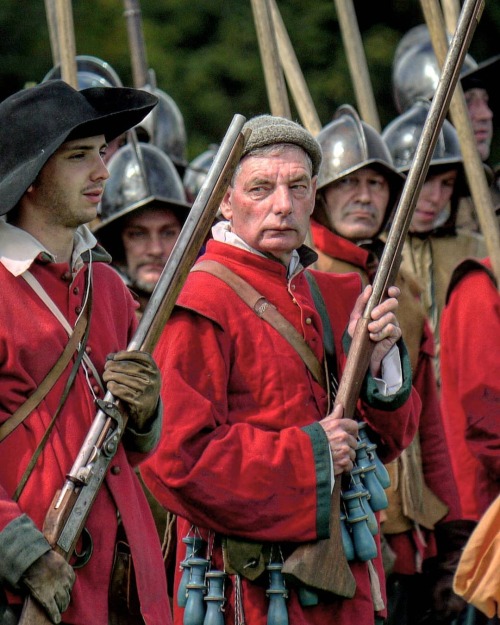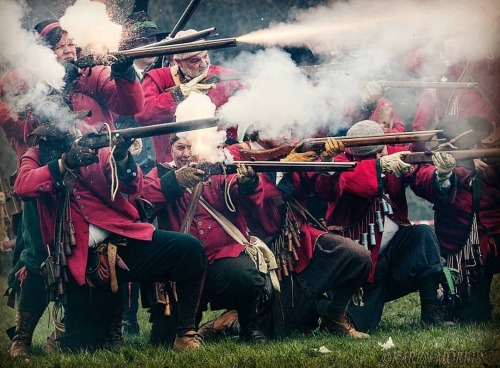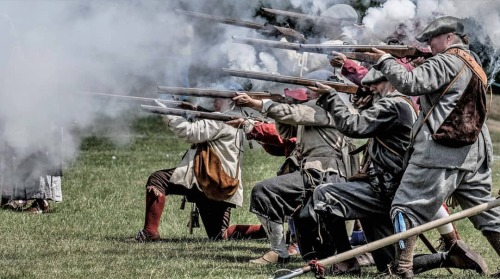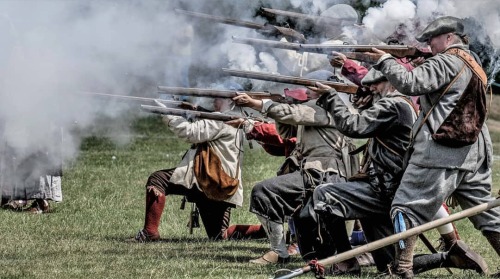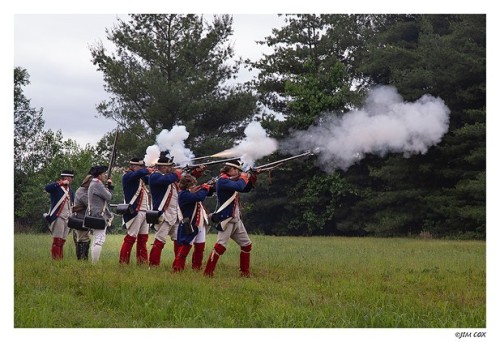#musket
Directions for Musters, published in 1638, described a musketeer’s principle equipment: “The musketier must be armed with a good musket (the barrel of 4 foot long, the bore of 12 bullets in the pound rowling in), a rest, bandelier, head-piece, a good sword, girdle & hangers.” The procedure for loading and firing a matchlock musket and how to organise and manage bodies of musketeers was described in a number of drill books. One of the most popular, running to asix editions between 1635 and 1661, was William Barriffe’s Military Discipline. This drill was based on that developed at the end of the 16th Century in the Netherlands by Prince Maurice of Nassau and it would become the universal drill of the Thirty Years War. The complete matchlock musket drill explained by Barriffe consisted of 60 different movements, each with its own command, of which 30 dealt with the process of loading and firing. Part of the complexity of the drill was due to the need to keep separate the powder and the means of igniting it, the slow-burning match. After firing, reloading was carried out without any further orders.
.
Kate Gray
.
#musket #musketeers #gun #war #battle #drill #drillmanual #photoreenactment #reenactment #reenactors #reenacting #reenactorstyle #reenactorslife #reenactorsofinstagram #reenactmentphotography #livinghistory #history #photohistory #historicalreenactment #17thcentury #sealedknot #dailyphoto #photoaday #photooftheday #photoadaychallenge #englishcivilwar #instadaily
https://www.instagram.com/p/B_yLg6JHw02/?igshid=15eyrf7fhzse
Post link
There’s no smoke without fire - and no musket firing without gunpowder! Nathaniel Nye was a master gunner from Worcester during the English Civil War and gave a recipe for black powder in 1647 of “four parts petre, one part Brimstone and one part Cole", which is four parts potassium nitrate (or saltpetre), one part sulphur and one part charcoal. Some powder used may have been manufactured by simply powdering the three components separately and then grinding them together in a mortar by hand. Larger scale production would be carried out in stamp mills where the powder mixture was pounded in wooden mortars by wooden-headed stamps, which were moved up and down by using horse or water power.
.
Powder was always in short supply, especially for the King’s forces. In his capital of Oxford, two corn mills were converted to produce gunpowder (helping precipitate a food shortage) and by the summer of 1643 a munitions plant established in the Schools at Oxford was supplying a range of military stores including gunpowder, slow match, bullets, pikes and bills. However, production was limited: in July 32 barrels of gunpowder were delivered and the following month a further 15 but it was not until November that a further 50 barrels were supplied. As there were no natural deposits of saltpetre in the country, Oxford, like all other gunpowder mills in England, was dependent upon supplies manufactured by a slow and unpleasant process from human and animal waste. Despite the best efforts of the king’s ordnance officers at Oxford, production in the city was not sufficient to meet the demand for arms and ammunition.
.
Karen Morris
.
#musket #musketeers #fire #smoke #gun #gunpowder #blackpowder #photoreenactment #reenactment #reenactors #reenacting #reenactorstyle #reenactorslife #reenactorsofinstagram #reenactmentphotography #livinghistory #history #photohistory #historicalreenactment #17thcentury #sealedknot #dailyphoto #photoaday #photooftheday #photoadaychallenge #englishcivilwar #instadaily #historyhit #oxford #oxforduniversity
https://www.instagram.com/p/B_n4tGXHqQI/?igshid=1cojwa9ic9tya
Post link
Musketeer Kel keeps his match burning during an event at Peterborough Cathedral by gently blowing on it. ‘Slow match’ was thin hemp or flax cord that had been soaked in a solution containing saltpetre – otherwise known as potassium nitrate and commonly extracted from urine – which would burn slowly and steadily. It was estimated at the time that a single soldier on guard duty would burn through a mile of match in a year. As well as being almost useless when it was raining, musketeers who were careless about their match and gunpowder could easily find themselves scattered over a wide area. The rise of the flintlock, which ignited its gunpowder with a piece of flint scraped along a metal plate, gradually saw the matchlock replaced though it persisted well into the 1700s. During the English Civil War, flintlocks were mostly used for guard duty and for soldiers guarding powder stores where burning match might cause a problem.
.
#musket #musketeers #match #slowburn #photoreenactment #reenactment #reenactors #reenacting #reenactorstyle #reenactorslife #reenactorsofinstagram #reenactmentphotography #livinghistory #history #photohistory #historicalreenactment #17thcentury #sealedknot #dailyphoto #photoaday #photooftheday #photoadaychallenge #englishcivilwar #instadaily
https://www.instagram.com/p/B_W9u_2n8I7/?igshid=ej7knu9o4pc0
Post link
“it is a wonder that men selected and packed off to war in this way … should ever have stood their ground at first musket fire.” - Stephen J. Stearns, ‘Conscription and English Society in the 1620s’
.
The historical record focuses much more on men who were forced to fight in the wars of the 17th Century than those who volunteered willingly, and so the view of military service in the Civil Wars is usually a negative one. This seems obvious in view of the account of the desperation that could drive one man to cut his own throat or another to cut off his own toe to avoid service. Men seized by recruiting partiesn for both sides were herded together and imprisoned before being marched off for minimal basic training and almost certain injury or death — the time-lapse between recruitment and action could be as little as three days. Desertion was a constant problem for armies relying on impressment, particularly Parliament’s “newly modelled” army, which was perennially short of both men and pay. Stories of almost half the impressed men who fought at Naseby fleeing the field or deserting soon after paint a vivid picture of unwilling recruits, unprepared for action. This image is sharply contradicted by reports from European sources, who noted English hardiness in war, and praises English and Scottish armies for their courage and resilience. As always, every soldier had his own story and this moment in history between the 'patronage’ armies of the medieval period and the professional armies of the late 17th Century onwards reveals so much about the many and varied reasons why men would march to war.
.
ABN Photography
.
#photoreenactment #reenactment #reenactors #reenacting #reenactorstyle #reenactorslife #reenactorsofinstagram #reenactmentphotography #livinghistory #history #photohistory #historicalreenactment #17thcentury #sealedknot #dailyphoto #photoaday #photooftheday #photoadaychallenge #englishcivilwar #instadaily #musketeers #musket #recruitment #recruiting #recruit
https://www.instagram.com/p/CAL5vc2HXhQ/?igshid=1vf1ku7x6nmuh
Post link
#Onthisday in 1645, the Royalist commander in Scotland, the Earl of Montrose, scored another spectacular victory against the Scottish Covenanters at the Battle of Auldearn. Outnumbered by more than two to one, Montrose destroyed half the Covenanter forces arrayed against him. With limited resources at his disposal Montrose had already secured a series of victories over Covenanter forces across the Highlands of Scotland. His latest assault on Dundee however was not so successful, and so Montrose retreated northwards, closely pursued by a Covenanter detachment commanded by Sir John Hurry.
.
Having joined forces with local militia loyal to the Covenanter cause, Hurry led a surprise attack on Montrose’s position close to the village of Auldearn, early in the morning of the 9 May. The intense fighting that followed continued for much of the day, with attack and counter attack until the Covenanter army finally broke and fled. Many of the casualties were inflicted in the merciless pursuit that continued for 14 miles.
.
Montrose’s string of victories would make him master of Scotland, with the Covenanter leaders even fleeing to England as he took Glasgow. But his fortune ran out in August 1645 at Philiphaugh. His first major defeat was decisive and he was unable to pose a serious threat to the Covenanters again. After the surrender of King Charles in England, Montrose received orders to disband his remaining forces. He negotiated terms for surrender in July 1646 and sailed away into exile in Norway on 3 September.
.
Levitt Parkes
.
#scotland #scottish #scottishhistory #auldearn #battle #musket #photoreenactment #reenactment #reenactors #reenacting #reenactorstyle #reenactorslife #reenactorsofinstagram #reenactmentphotography #livinghistory #history #photohistory #historicalreenactment #17thcentury #sealedknot #dailyphoto #photoaday #photooftheday #photoadaychallenge #englishcivilwar #instadaily
https://www.instagram.com/p/B_8tDc5Ham-/?igshid=zkl5fpv1kb1w
Post link
#Onthisday in 1645, the Royalist commander in Scotland, the Earl of Montrose, scored another spectacular victory against the Scottish Covenanters at the Battle of Auldearn. Outnumbered by more than two to one, Montrose destroyed half the Covenanter forces arrayed against him. With limited resources at his disposal Montrose had already secured a series of victories over Covenanter forces across the Highlands of Scotland. His latest assault on Dundee however was not so successful, and so Montrose retreated northwards, closely pursued by a Covenanter detachment commanded by Sir John Hurry.
.
Having joined forces with local militia loyal to the Covenanter cause, Hurry led a surprise attack on Montrose’s position close to the village of Auldearn, early in the morning of the 9th May. The intense fighting that followed continued for much of the day, with attack and counter attack until the Covenanter army finally broke and fled. Many of the casualties were inflicted after the Covenanter army broke and fled, in a merciless pursuit which was continued for 14 miles.
.
Montrose’s string of victories would make him master of Scotland, which the Covenanter leaders even fleeing to England as he took Glasgow. His fortune ran out in August 1645 at Philiphaugh. His first major defeat was decisive and he was unable to pose a serious threat to the Covenanters again. After the surrender of King Charles in England, Montrose received orders to disband his remaining forces. He negotiated terms for surrender in July 1646 and sailed away into exile in Norway on 3 September.
.
Levitt Parkes
#scotland #scottish #scottishhistory #auldearn #battle #musket #photoreenactment #reenactment #reenactors #reenacting #reenactorstyle #reenactorslife #reenactorsofinstagram #reenactmentphotography #livinghistory #history #photohistory #historicalreenactment #17thcentury #sealedknot #dailyphoto #photoaday #photooftheday #photoadaychallenge #englishcivilwar #instadaily
https://www.instagram.com/p/B_8tDc5Ham-/?igshid=7k9arpk7zjzn
Post link
Smoke and Fire.
At Vincennes, Indiana Annual Spirt Rendezvous.
.
.
the flashing of death
the enemy advances
who’s the enemy
.
#haiku
#575
#poetry
#poet
#poetsofinstagram
#photography
#photographer
#photographersofinstagram
#digitalphotography
#availablelightphotography
#naturallightphotography
#vintagestylenotvintagevalues
#vincennes
#indiana
#spirtofvincennes
#spiritrendezvous
#reenactor
#historicallyadequate
#periodadequate
#cannon
#cannonfire
#cannonsmoke
#flintlock
#musket
#flintlockfire
#flintlocksmoke (at George Rogers Clark National Historical Park)
https://www.instagram.com/p/CPgraY6Bmcb/?utm_medium=tumblr
Post link


